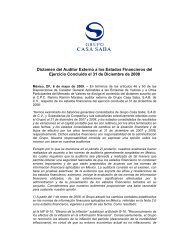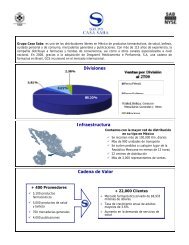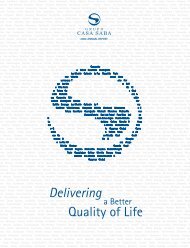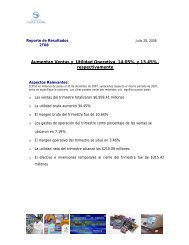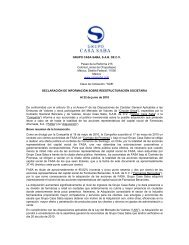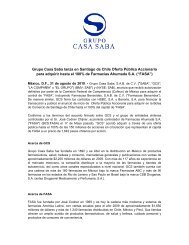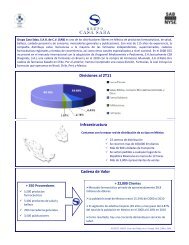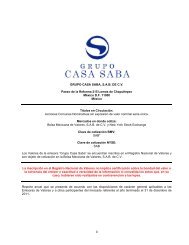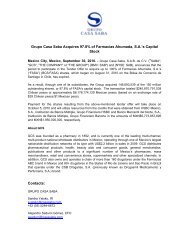FORM 20-F Grupo Casa Saba, S.A.B. de C.V.
FORM 20-F Grupo Casa Saba, S.A.B. de C.V.
FORM 20-F Grupo Casa Saba, S.A.B. de C.V.
Create successful ePaper yourself
Turn your PDF publications into a flip-book with our unique Google optimized e-Paper software.
FRS C-4. “Inventories” (FRS C-4)<br />
This accounting standard substitutes Mexican Bulletin C-4 with the same name. Effective <strong>20</strong>11, the main changes are: (i) the direct costing system is eliminated; (ii) the allocation formula<br />
of the “last-in/first-out” cost of inventories is eliminated; (iii) inventory valuation should consi<strong>de</strong>r the lower of acquisition cost or its net realization value; (iv) impairment losses are<br />
recor<strong>de</strong>d in the cost of sales and reversed by <strong>de</strong>creasing the cost of sales when the circumstances that generate it no longer exist. The Group adopted retrospectively the new FRS C-4,<br />
“Inventories”. This standard superse<strong>de</strong>s the Bulletin with the same name. That adoption had no impact on the consolidated financial statements.<br />
FRS C-5. “Prepaid expenses” (FRS C-5)<br />
This accounting standard substitutes Mexican Bulletin C-5 with the same name. Effective <strong>20</strong>11, the Group adopted retrospectively the new Mexican FRS C-5, "Prepaid expenses" that<br />
superse<strong>de</strong>s the Bulletin with the same name. Accordingly, prepaid expenses are presented as a current asset when the period in which their benefits are expected to be obtained is equal<br />
to or less than one year. Prepaid expenses for goods are presented in the short-term or long-term, <strong>de</strong>pending on the classification of the item inten<strong>de</strong>d (e.g.: inventory or property and<br />
equipment). That adoption had no impact on the consolidated financial statements.<br />
FRS C-6. “Property, plant and equipment” (FRS C-6)<br />
This accounting standard will replace Mexican Bulletin C-6 with the same name. Effective January 1, <strong>20</strong>11, the main changes, whose application is prospective, are: (i) it sets forth the<br />
gui<strong>de</strong>lines for recognizing the exchange of nonmonetary assets at fair value and the bases for <strong>de</strong>termining the residual value of a component; and (ii) the unused component should be<br />
<strong>de</strong>preciated, unless <strong>de</strong>preciation is <strong>de</strong>termined based on the activity of the component.<br />
Effective <strong>20</strong>11, the Group adopted retrospectively the new Mexican FRS C-6, "Property, plant and equipment" that superse<strong>de</strong>s Bulletin C-6, "Property, machinery and<br />
equipment". That adoption had no impact on the consolidated financial statements.<br />
“Improvements to <strong>20</strong>11 Financial Information Standards”<br />
Effective January 1, <strong>20</strong>11, the main changes are as follows:<br />
(i) FRS B-1. “Accounting changes and error corrections” for presenting the opening statement of financial position if adjustments are retrospective. In our Note 3 a) to our financial<br />
statements, we <strong>de</strong>termined various events or circumstances existing at the acquisition date of FASA, which required an adjustment to the recognized amounts of the acquisition. As a<br />
result, the Company recor<strong>de</strong>d certain liabilities incurred, as well as the impairment of some long-lived assets retrospectively to the date of completion of the business acquisition.<br />
86



